East Africa Battery Market Size
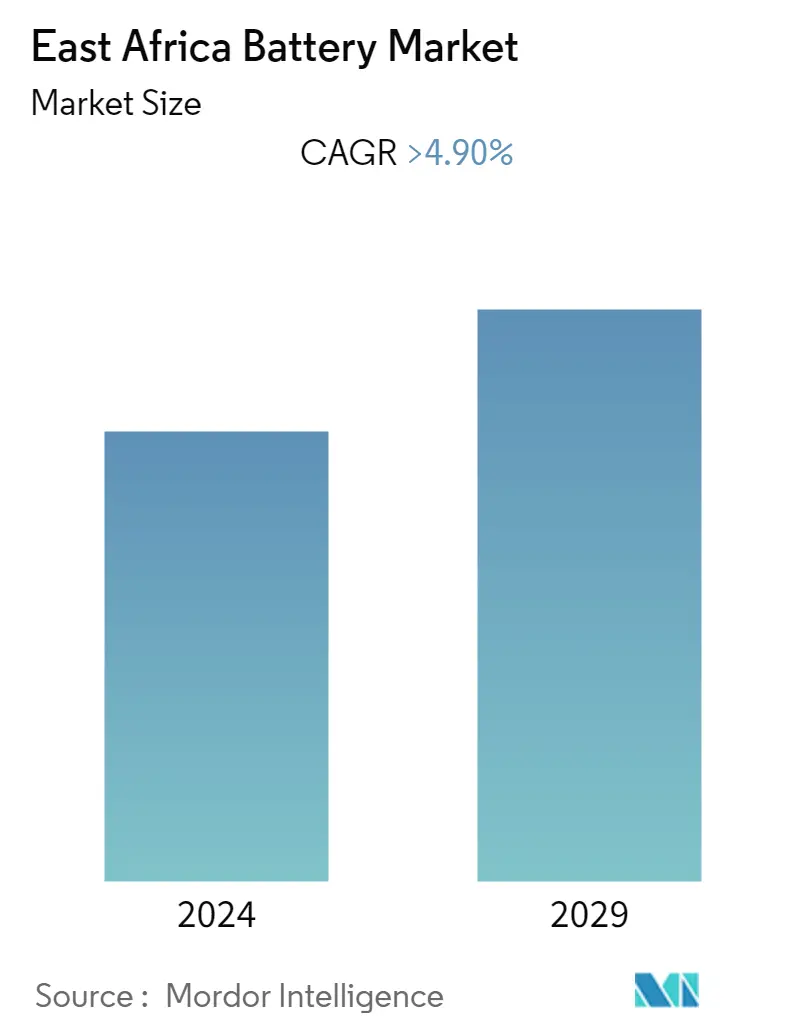
| Study Period | 2020 - 2029 |
| Base Year For Estimation | 2023 |
| Forecast Data Period | 2024 - 2029 |
| Historical Data Period | 2020 - 2022 |
| CAGR | > 4.90 % |
| Market Concentration | Medium |
Major Players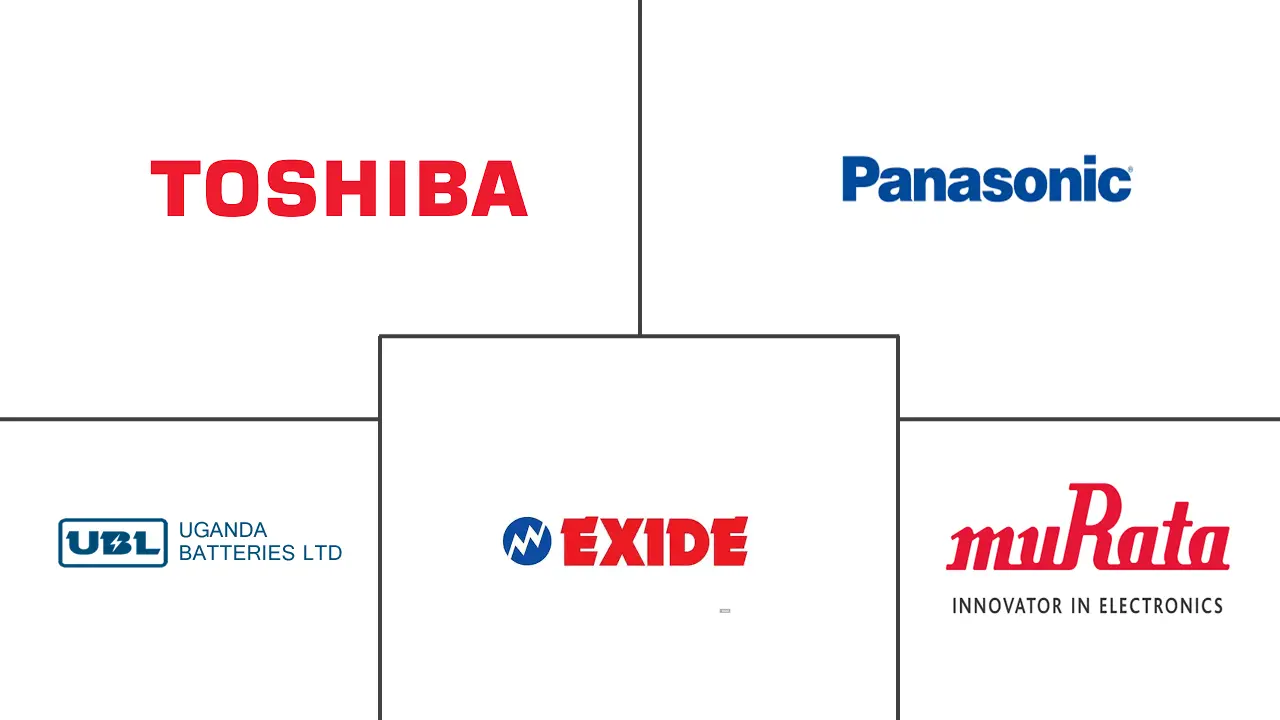
*Disclaimer: Major Players sorted in no particular order |
East Africa Battery Market Analysis
The East African battery market is expected to record a CAGR of more than 4.9% during the forecast period of 2022-2027. The East African battery market was moderately impacted by the COVID-19 outbreak in Q1 2020. The growth of the market declined due to the lockdowns imposed that restricted the supply of batteries and other components as a result of severe disruptions in businesses and the global economy. The COVID-19 pandemic exposed the over-dependency of other countries, especially on China, for imported batteries and key raw materials. Factors such as the increasing adoption of renewable energy by countries in the region and the rapidly growing telecom sector are likely going to drive the East African battery market. However, low domestic and foreign investments are expected to restrain the East African market during the forecast period.
The lithium-ion battery segment, due to the significant reduction in the manufacturing and retail cost, has become more accessible to people for everyday use, such as in mobile phones and other electronic devices, and is likely going to be the fastest-growing segment in East African battery market.
The increasing deployment of renewable energy and growing usage of battery electric vehicles across Uganda and Rwanda are likely to create several opportunities for the East African battery market in the future.
Ethiopia is expected to be the fastest-growing market for the East African battery market during the forecast period because of its increasing solar and wind energy installations and upcoming projects to generate clean energy.
East Africa Battery Market Trends
This section covers the major market trends shaping the East Africa Battery Market according to our research experts:
Lithium-ion Battery Segment Expected to be the Fastest-growing Market
Lithium-ion batteries are a rechargeable type of battery that is commonly used in electronic devices and energy vehicles. These batteries are also being used for the storage of energy from renewable energy sources such as solar and wind.
The energy densities of these batteries are quite high and have a round trip efficiency of 85 to 95%, which indicates the ratio of energy output/released to energy input/stored. The lithium-ion battery is a low maintenance battery, and the cells of the battery cause little harm to the environment when disposed of.
The governments of the region's countries are promoting and continually supporting any foreign or local investments in electric vehicles (EV) in their countries. Many countries such as Uganda, Kenya, and Rwanda see electric cars as a long-term solution for reducing the carbon footprint in the region.
In August 2020, state-owned Kiira Motors Corp. announced plans to manufacture 5,000 electric vehicles per year, including buses. The company is planning to build an electric bus production facility in the country by 2022. These developments in the electric vehicle sector are likely going to have a positive impact on the lithium-ion battery segment as most electric vehicles use it to generate power.
Moreover, in June 2021, the Government of Rwanda announced a prioritization of the transition to e-mobility for all vehicle types. The estimated cost of transitioning to e-mobility and the adoption of electric vehicles in Rwanda is USD 900 million.
Hence, owing to the above factors, the lithium-ion segment is expected to be the fastest-growing segment in the East African battery market during the forecast period.
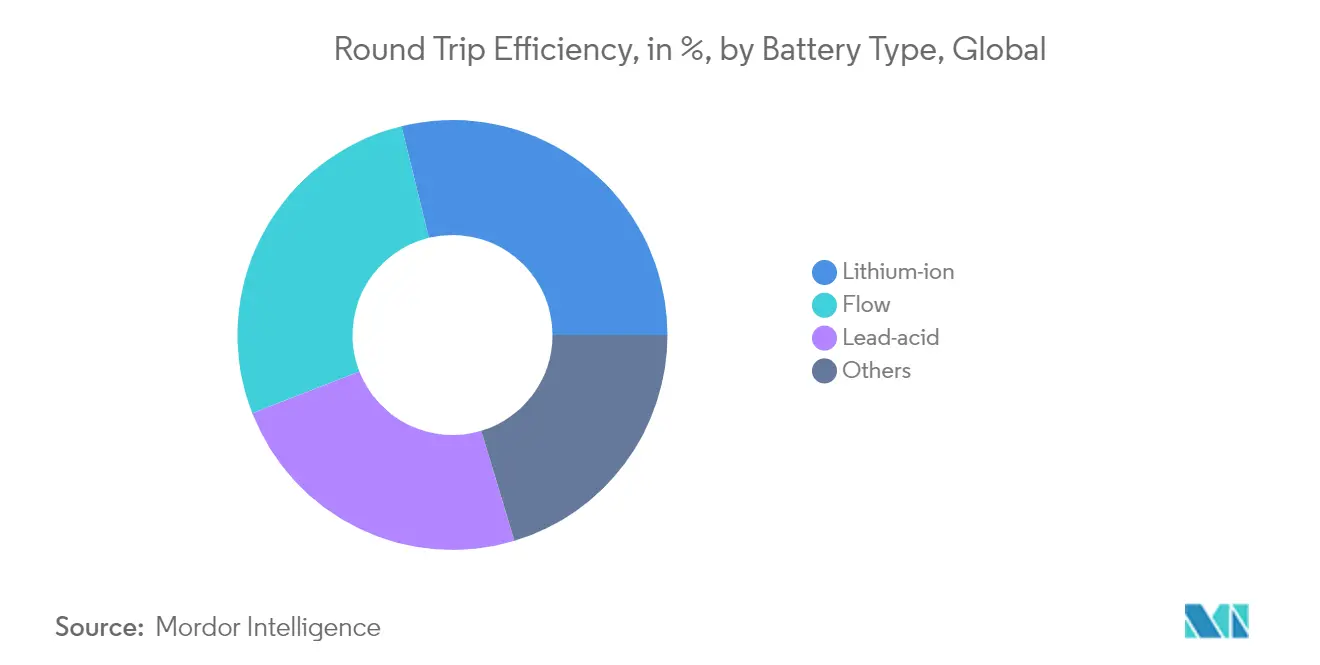
Ethiopia Expected to Witness Significant Market Growth
Ethiopia is the second-largest economy in Eastern Africa and has been continually seeking investments from other countries across the globe for the development of renewable energy manufacturing facilities. More renewable energy in the country is expected to open doors to the market for battery storage systems.
The Ethiopian government previously had a monopoly on telecom services, including mobile, internet, and data communications. For several years, Ethiopia's monopolistic control degraded innovation, restricted network expansion, and limited the scope of services. In recent years, the Government of Ethiopia approved legislation to open the market to competition and provide much-needed foreign investment. This announcement by the government is likely to boost the mobile battery market in the country.
In 2020, Ethiopia's total installed solar capacity was 20 megawatts (MW), which is comparatively higher than the 10 megawatts (MW) installed in 2015. Moreover, the government plans to increase solar installations in the future rapidly. This is likely to drive the battery market as batteries can be used to store extra power generated from renewable sources.
In June 2020, Lotus Energy Cooperative won a contract to build a solar complex combining solar, battery storage, and waste-to-energy capacity in Ethiopia. The 500 MW facility is expected to power the infrastructure of the Ethiopian conglomerate Effort Group (Tigray Rehabilitation Endowment Fund). The project has an investment cost of USD 4.3 billion.
Moreover, in December 2020, Sino Soar, with its consortium, won the bid for the 25 Villages PV-Diesel-Battery Micro-grid EPC project in Ethiopia. The project is funded by the African Development Bank and includes 2 MWp PV, 5.5 MWh Battery Energy Storage System, 450 kW Diesel Gen-set, and Energy Management Systems.
Hence, owing to the above factors, Ethiopia is expected to be the fastest-growing country in the East African battery market during the forecast period.
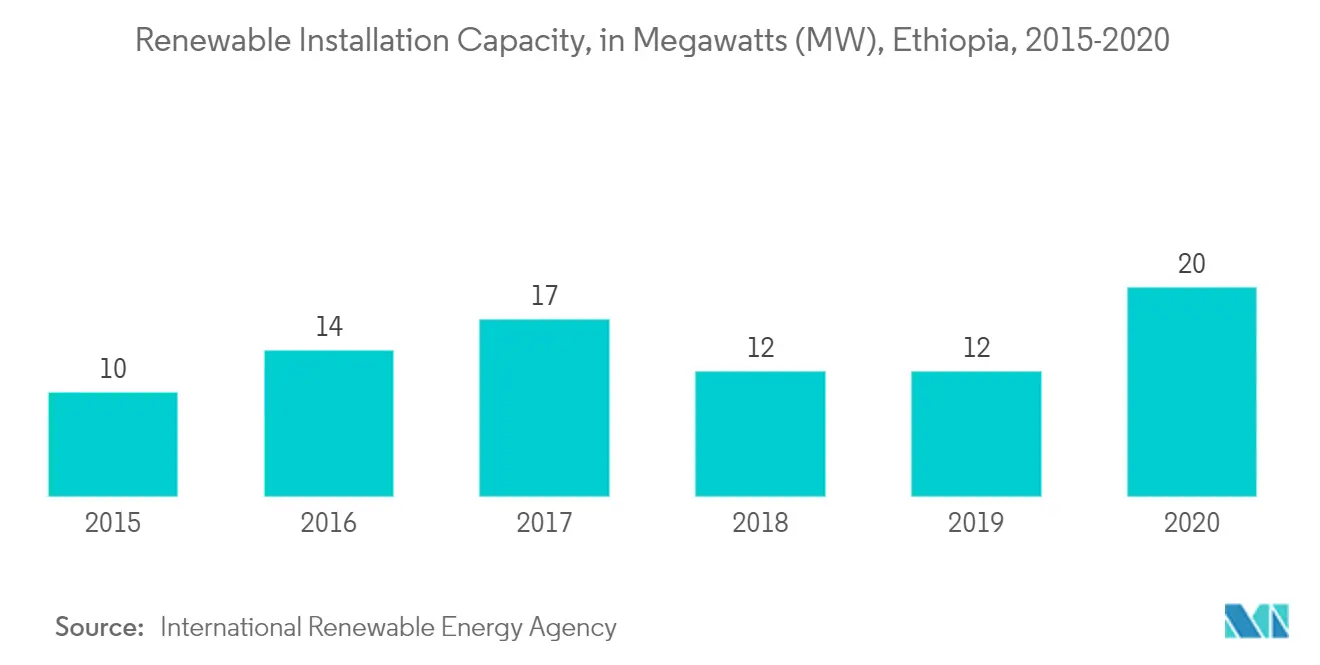
East Africa Battery Industry Overview
The East African battery market is moderately fragmented. Some of the key players in this market include Toshiba Corporation, Murata Manufacturing Co. Ltd, Exide Industries Ltd, Panasonic Corporation, and Uganda Batteries Ltd, among others.
East Africa Battery Market Leaders
-
Toshiba Corporation
-
Murata Manufacturing Co., Ltd
-
Panasonic Corporation
-
Exide Industries Ltd
-
Uganda Batteries Limited
*Disclaimer: Major Players sorted in no particular order
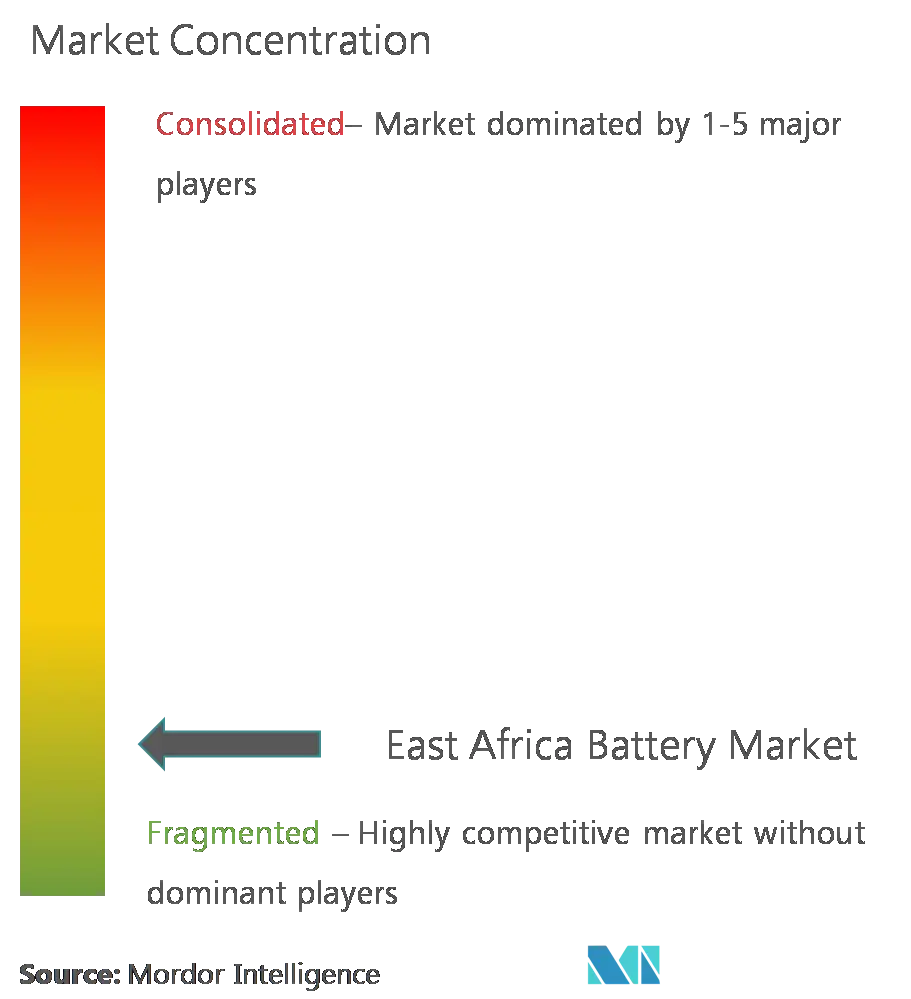
East Africa Battery Market News
In February 2021, Winch Energy, an off-grid utility provider, completed the funding for solar mini-grid projects in 49 villages across Uganda and Sierra Leone. The project includes 6,000 portable batteries installed through the project to provide people outside of the mini-grid catchment area with clean electricity.
In December 2021, Development Bank of Rwanda (BRD) announced plans to develop solar PV and hydro mini-grids ranging in size from 10 kW to 1 MW in Rwanda. The Rwandan authorities have planned these hybrid mini-grids coupled with battery storage.
East Africa Battery Market Report - Table of Contents
1. INTRODUCTION
1.1 Scope of the Study
1.2 Market Definition
1.3 Study Assumptions
2. EXECUTIVE SUMMARY
3. RESEARCH METHODOLOGY
4. MARKET OVERVIEW
4.1 Introduction
4.2 Market Size and Demand Forecast in USD billion, till 2027
4.3 Recent Trends and Developments
4.4 Government Policies and Regulations
4.5 Market Dynamics
4.5.1 Drivers
4.5.2 Restraints
4.6 Supply Chain Analysis
4.7 Porter's Five Forces Analysis
4.7.1 Threat of New Entrants
4.7.2 Bargaining Power of Consumers
4.7.3 Bargaining Power of Suppliers
4.7.4 Threat of Substitute Products and Services
4.7.5 Intensity of Competitive Rivalry
5. MARKET SEGMENTATION
5.1 Type
5.1.1 Primary Battery
5.1.2 Secondary Battery
5.2 Technology
5.2.1 Lithium-ion Battery
5.2.2 Lead-acid Battery
5.2.3 Other Technologies
5.3 Application
5.3.1 Industrial Batteries
5.3.2 Portable Batteries
5.3.3 Other Applications
5.4 Geography
5.4.1 Kenya
5.4.2 Ethiopia
5.4.3 Tanzania
5.4.4 Rest of East Africa
6. COMPETITIVE LANDSCAPE
6.1 Mergers, Acquisitions, Collaborations, and Joint Ventures
6.2 Strategies Adopted by Key Players
6.3 Company Profiles
6.3.1 Exide Industries Ltd
6.3.2 Toshiba Corporation
6.3.3 Murata Manufacturing Co. Ltd
6.3.4 Panasonic Corporation
6.3.5 Duracell Inc.
6.3.6 ABM Group
6.3.7 Trojan Battery Company
6.3.8 Uganda Batteries Limited
6.3.9 Bodawerk International Ltd
- *List Not Exhaustive
7. MARKET OPPORTUNITIES AND FUTURE TRENDS
East Africa Battery Industry Segmentation
The East African battery market report includes:
| Type | |
| Primary Battery | |
| Secondary Battery |
| Technology | |
| Lithium-ion Battery | |
| Lead-acid Battery | |
| Other Technologies |
| Application | |
| Industrial Batteries | |
| Portable Batteries | |
| Other Applications |
| Geography | |
| Kenya | |
| Ethiopia | |
| Tanzania | |
| Rest of East Africa |
East Africa Battery Market Research FAQs
What is the current East Africa Battery Market size?
The East Africa Battery Market is projected to register a CAGR of greater than 4.90% during the forecast period (2024-2029)
Who are the key players in East Africa Battery Market?
Toshiba Corporation, Murata Manufacturing Co., Ltd, Panasonic Corporation, Exide Industries Ltd and Uganda Batteries Limited are the major companies operating in the East Africa Battery Market.
What years does this East Africa Battery Market cover?
The report covers the East Africa Battery Market historical market size for years: 2020, 2021, 2022 and 2023. The report also forecasts the East Africa Battery Market size for years: 2024, 2025, 2026, 2027, 2028 and 2029.
East Africa Battery Industry Report
Statistics for the 2024 East Africa Battery market share, size and revenue growth rate, created by Mordor Intelligence™ Industry Reports. East Africa Battery analysis includes a market forecast outlook to 2029 and historical overview. Get a sample of this industry analysis as a free report PDF download.



